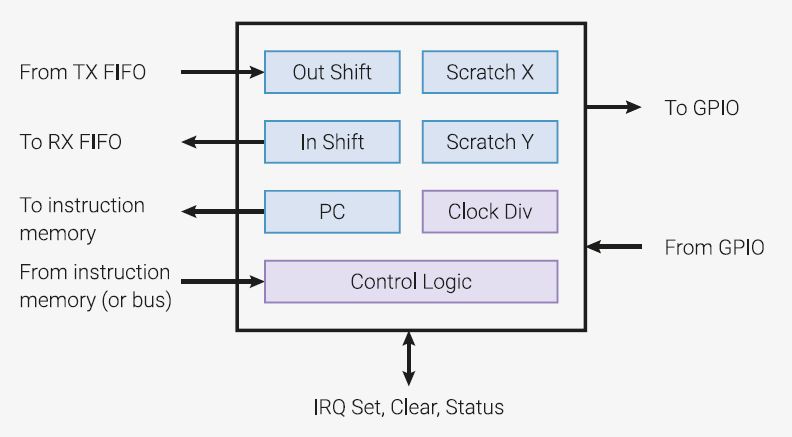Table of Contents
PIO (dis)assembler v2 for RP2040
The idea:
PIO stand for Programmable Input Output. These are programmable state machines
with a small shared program memory. Programs are built with only eight instructions. The
behavior of those instructions can be modified with registers.
We define a (standalone) PIO forth style (dis)assembler for the RP2040. It can be used for writing direct executable programs and exportable HEX programs. These HEX programs can be used in conjunction with the mini-PIO control program.
Implementation
Note that; this is version-2 of the PIO (dis)assembler.
This version is more flexible and is prepared for more than two PIO's.
The sample code assumes a 32-bit machine with 32-bit compile operations.
It is also assumed that the code runs in RAM as noForth t on the RP2040 does.
All PIO fuctionality can be used, and a PIO-module EXPORT function is provided.
The PIO-assembler is (de)activated by the words {PIO and PIO}.
Missing words in Generic Forth are:
+TO ( n "name" -- ) - Add n to the contents of the value "name" VOCABULARY ( "name" -- ) - Define a named wordlist
The structure of PIO opcodes
Pink = Opcode field Yellow = Delay and/or side set field Green = Destination field Blue = Data field
All PIO instructions
✦ PIO opcodes
in, out, push, pull, mov, wait,
irq, set, nop, pio,
✦ Optional arguments for each opcode
[] side
✦ Conditionals
x0<>? x--? y0<>? y--? x=y? pin?
osre?
✦ Control structures
if, else, then, begin, while, repeat,
again, until,
✦ Labels
one two three one> two> three>
✦ PIO directives
clean-pio =pio sm sync restart
=org =set-pins =out-pins =side-pins opt
=in-pin =jmp-pin =inputs =strength side-pindirs
wrap-target wrap =steal =autopush =autopull
=in-dir =out-dir clone =exec =clock-div
=freq export
✦ PIO external tools (mini-PIO.f)
tx-depth rx-depth >txf rxf> =pio
sm-on exec-opc set-freq clock-div sync
restart
✦ PIO disassembler & state machine data
psee psee0 psee1 .fifo .sm
Usage example
An extra RS232 output driver in only 5 instructions!
decimal
: =BAUD ( b -- ) 8 * =freq ; \ Set baudrate for UART
clean-pio \ Empty code space, start at zero
0 0 {pio \ Use state machine-0 on PIO-0
115200 =baud \ 115k2
26 1 =side-pins opt \ GPIO 26 for optional SIDE
26 1 =out-pins \ GPIO 26 for OUT & SET
26 1 =set-pins
1 pindirs set, \ Pin is output!
wrap-target
7 [] 1 side pull, \ Stop bit, get data byte
7 [] 0 side 7 x set, \ Start bit
begin,
1 pins out, \ Shift 8 bits out
6 [] x--? until, \ Until 8 bits are done
wrap
0 =exec \ Start SM-0 code at address 0
pio}
UART control code
: PEMIT ( ch -- ) begin 0 tx-depth 3 < until 0 >txf ; : PTYPE ( a u -- ) 0 ?do count pemit loop drop ; : ABC ( -- ) s" ABC " ptype ;
| File name | Purpose | in Dropbox (external link) |
| PIO-assembler-docs-v2.pdf | Documentation | PIO-assembler-docs-v2.pdf |
| PIO assembler overview.pdf | Documentation | PIO-assembler overview |
| PIO-assembler-v2-uni.f | PIO-assembler | noForth PIO assembler |
| PIO-disassembler-v2 uni.f | PIO-disassembler | noForth PIO disassembler |
| mini-PIO-v2 uni.f | Mini PIO controller | noForth minimal PIO controller |



